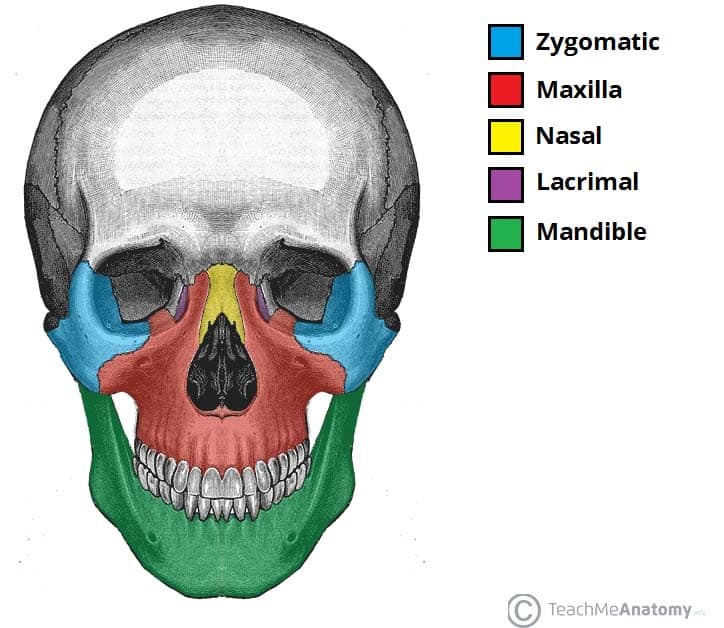Back Of Skull Anatomy | Learn vocabulary, terms and more with flashcards, games and other study tools. The cranial vault denotes the top, sides, front, and back of the cranium. Continue scrolling to read more below. The cranium and the mandible. It is comprised of many bones, formed by intramembranous ossification, which are joined together by sutures (fibrous joints).
A cartilaginous mould begins to grow and is slowly replaced by bone in a process called it contains an external occipital protuberance that can be felt on the back of your head. Between parietal bone and temporal bone on side of the skull, bordered in back by occipital bone. The skull begins to form prior to week 12 of embryogenesis. The skull is the bony skeleton of the head. Please feel free to download and print.

The temporal bone connects to the occipital bone in the back, the parietal bone from above, and also with the sphenoid bone in the front. Looking at it from the inside it can be subdivided into. This portion of the skull base consists of the orbital portion of the frontal bone. The skull is a bony structure that supports the face and forms a protective cavity for the brain. Skull, skeletal framework of the head of vertebrates, composed of bones or cartilage, which form a unit that protects the brain and some sense organs. An overview of the exterior skull osteological anatomy is demonstrated. It offers protection to the brain, eye balls, inner ears, and nasal passages. Continue scrolling to read more below. Radiographic atlas of skull and brain anatomy. Their number and location vary. The skull has a single occipital condyle.7 the skull consists of five major bones: From an anatomical perspective, the skull is divided into two parts: In order to be light, the skull is made up by flat and irregular bones, and has hollow spaces called the sinuses.
The bones of the skull provide protection for the brain and the organs of vision, taste, hearing, equilibrium, and smell. This portion of the skull base consists of the orbital portion of the frontal bone. Learn vocabulary, terms and more with flashcards, games and other study tools. The cranial vault denotes the top, sides, front, and back of the cranium. The base of the skull (or skull base) forms the floor of the cranial cavity and separates the brain from the structures of the neck and face.

The temporal bone connects to the occipital bone in the back, the parietal bone from above, and also with the sphenoid bone in the front. Understanding the human skull anatomy is necessary for a wide range of professionals from doctors (dentists, oral surgeons, neurosurgeons, etc.) to the structure of the skull bones is to a large extent determined by and interconnected with the anatomy of the sensory organs, situated in the head, as. The base of the skull (or skull base) forms the floor of the cranial cavity and separates the brain from the structures of the neck and face. The skull has a single occipital condyle.7 the skull consists of five major bones: Looking at the lumpy, bumpy bits inside and outside the skull and mandible, adding on to the foramina that we were talking about last week. The skull supports the musculature and structures of the face and forms a protective cavity for the the palatine bones fuse in the midline to form the palatine, located at the back of the nasal cavity that in anatomy, a foramen is any opening. The cranial vault denotes the top, sides, front, and back of the cranium. Please feel free to download and print. Foramina inside the body of humans and other animals. Continue scrolling to read more below. Cranial cavity , cranial sutures. The skull includes the upper jaw and the cranium. The separation of the cranial bone plates at time of birth facilitate passage of the head of the fetus through the mothers birth canal or p.
The skull or known as the cranium in the medical world is a bone structure of the head. Radiographic atlas of skull and brain anatomy. The bones of the skull provide protection for the brain and the organs of vision, taste, hearing, equilibrium, and smell. The skull performs vital functions. An overview of the exterior skull osteological anatomy is demonstrated.

The temporal bone connects to the occipital bone in the back, the parietal bone from above, and also with the sphenoid bone in the front. Their number and location vary. The foramen magnum, housing the brainstem, is also a part of the. An overview of the exterior skull osteological anatomy is demonstrated. The cranium and the mandible. The skull is a bony structure that supports the face and forms a protective cavity for the brain. Learn vocabulary, terms and more with flashcards, games and other study tools. Human skull from the front. Radiographic atlas of skull and brain anatomy. The skull begins to form prior to week 12 of embryogenesis. Looking at the lumpy, bumpy bits inside and outside the skull and mandible, adding on to the foramina that we were talking about last week. It is comprised of many bones, formed by intramembranous ossification, which are joined together by sutures (fibrous joints). The ethmoid bone forms the central part of the floor, which is the deepest area of the anterior cranial fossa.
Back Of Skull Anatomy: The bones of the skull provide protection for the brain and the organs of vision, taste, hearing, equilibrium, and smell.
0 comments:
Post a Comment